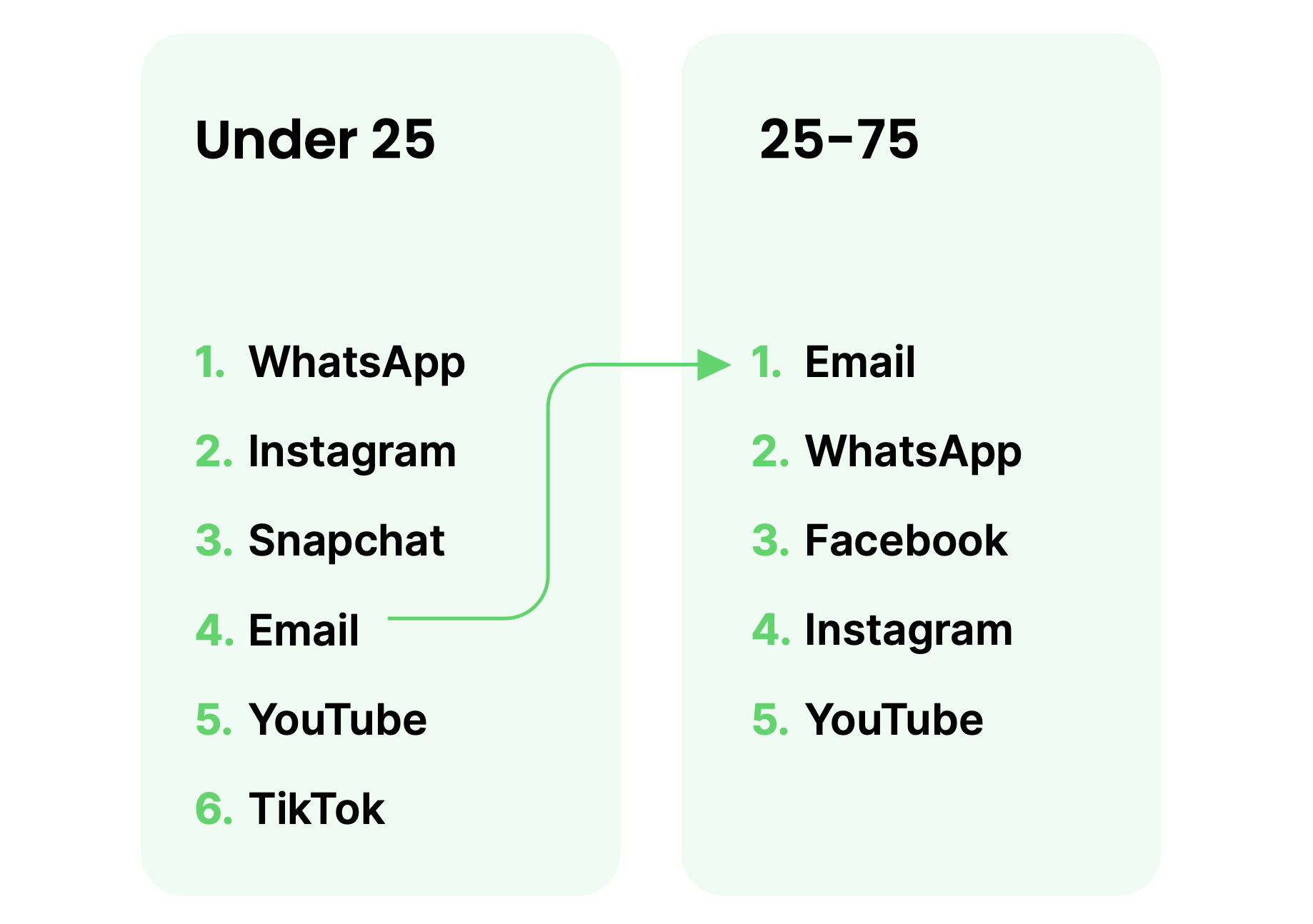
Why is email still the preferred daily communication method for older generations?
Email remains the most popular digital communication channel for most Finnish people. We conducted a small interview study to dig deeper into its appeal among the older generations.
Our research showed that flexibility and message history are the main reasons for the popularity of email. People are willing to wait a couple of business days for a reply but not any longer before switching to a different communication channel.
Over fifty years since the very first email was sent in 1971, the deluge of email traffic is only growing bigger by the year. Over four billion email users send more than 300 billion emails every year according to Statista.
Our Finnish consumer data collected in The Digital Everyday Life in Finland 2022 survey corroborated the fact that email remains the number one digital channel for all Finns over 25. No wonder that, in marketing, email campaigns are only increasing.

We then held ten semi-structured interviews to get more insight on top of the quantitative data. These were a follow-up to Qvik’s survey, Digital Everyday Life in Finland 2022. The purpose of the interviews was to gather qualitative data regarding people’s email habits and attitudes alongside the quantitative data on digital communications channel use.
We interviewed both women and men aged between 41 and 70. The interviews were conducted online by one researcher and analyzed by two independent researchers.
Findings: Checking your email is a daily routine
Nearly all interviewees read their emails at least once a day, some even multiple times per day. Notification settings depended on the device – none of the interviewees had notifications on desktop, but some used them on mobile. Many tend to have a morning or evening routine for reading emails, which is why they manage without notifications.
“I decide when to read my emails – I don’t want to use notifications.”
Man, 64
Conversation history and availability beat one-off chats
The interviewees use email to communicate about complex and serious topics, often with unfamiliar people. For example, many of the interviewees used email to communicate with their bank and insurance company. In these contexts, chats were also seen as a convenient way to communicate, but email had the advantage of storing the conversation history.
Nearly all interviewees chose email over chat due to the conversation history aspect and over phone because of the possibility to reply at their own convenience.
“I prefer to use email for important messages since it creates a ‘receipt’ of the conversation, making it easier to recall details afterwards.”
Woman, 66
Response expected in 2 business days
One disadvantage of email use cited by the interviewees is the slow response time. This is where phone calls beat email and why people use other channels, such as WhatsApp, to communicate with people they know.
However, all interviewees expected to receive a response from unfamiliar parties within a couple of days, and in three days at the latest.The interviewees also expect a formal, but friendly corporate tone of voice in email communication – just like they would in face-to-face customer service contexts.
“I now only use email for formal messages, not to communicate with family or friends.”
Woman, 41
Storage for important documents
Several interviewees said that their email usage has changed with the appearance of other communication channels, such as WhatsApp, which has decreased email communication with familiar people a lot.
“In the past, we used to catch up with friends by email during the work day. Nowadays we talk on WhatsApp.”
Woman, 67
On the rare occasions on which interviewees did use email to reach friends and family members, it was because of the topic. Some of the interviewees preferred to share links via email rather than in WhatsApp. In these situations, no answer was even excepted from the recipient.
“My father was looking for a new vacuum cleaner and I found a suitable option for him. I shared the link with him by email and did not expect a reply, even though I knew that he bought the vacuum cleaner and was happy for my help.”
Man, 53
Formal and friendly tone of voice expected
When a consumer runs into the limits of self-service, they have to contact the company in some way. Email is overwhelmingly the most popular communication channel for this purpose, regardless of the respondent’s age.
The text format in general was considered to cause more misunderstandings than face-to-face meetings or phone calls due to the need to shorten the message and different levels of textual skill.
“Email is suitable for topics that do not require much explanation – challenging subjects are easier to handle on the phone.”
Man, 42
“You may say things more abruptly than you would face to face, as you are trying to put it briefly – the friendly tone of voice gets left out. Especially, if the other message is copy-pasted and very generic, I tend to respond with less decorum. You need to think about the tone of voice more carefully than in phone calls.”
Woman, 66
From companies, interviewees expect a formal but friendly tone of voice in their email communication – just as they would in face-to-face customer service contexts.
“I expect companies to respond in a friendly way, but people can do as they like…”
Man, 42
Conclusions: future of email
People over 25 prefer email over other communication channels and, based on our interviews, email users are quite happy about the channel. It seems that email still has its purpose –communicating about meatier topics, mostly with unfamiliar people.
As other communication channels are gaining ground and the younger generation is using email very actively, it will be interesting to see how popular email will remain as a communication method in the future.







